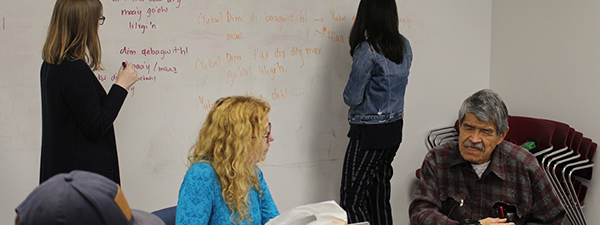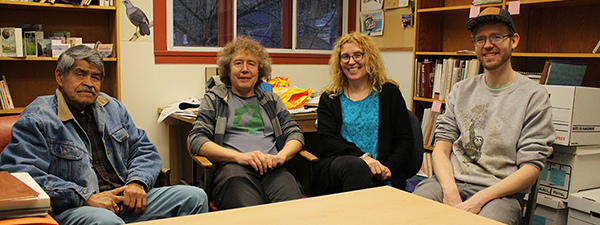 January 17, 2019 – “My name is Gawagani. I come from the house of Gamlaxyeltxw.”
January 17, 2019 – “My name is Gawagani. I come from the house of Gamlaxyeltxw.”
Gawagani, or Vincent Gogag, is 1,200 kilometres from home, and has just finished speaking the Gitksan language for a group of students on a Wednesday afternoon.
This is part of Gogag’s role as a language consultant with the University of British Columbia Gitksan Research Lab. As an English as a Second Language teacher, he never thought much about teaching the Gitksan language in schools or villages, he said. In residential schools, English was the only way to communicate with non-Gitksan speakers. “Today, it’s very much needed, because we are losing the language.”
There are reportedly 522 fluent Gitxsenimx speakers, an alternative spelling of the language, out of a population of 9,849, according to the First Peoples’ Cultural Council 2018 Report on the Status of B.C. First Nations Languages. This is up from 350 in 2014, but the report advises each publication should be considered a snapshot at a particular time, given different sets of communities reporting, population growth, and community-specific variability in data reporting.
Lab co-director and Language Sciences Initiative member Professor Henry Davis said this difference is likely a difference in reporting, not in actual number of speakers. While the number of Gitksan second language speakers has likely increased since the Lab’s formation in 2010, the number of remaining first language speakers – those who learned the language from their parents, such as Gogag – has declined, Davis said. “Gitksan language learning by children in their home environment is something that’s not happening anymore.”
Language is core to Gitksan life. It is used for feasts, a tradition that combines economics, language and culture; Canadian government documents are translated into Gitksan for elders; and oral histories, stories, and speeches are passed down from clan to clan, house to house, Gogag said.
“It’s very important for our language to be spoken.”

L to R: Vincent Gogag; Henry Davis; Lisa Matthewson; and Gitksan Research Lab Coordinator Michael Schwan.
Language retention is vital to the health of a community, Lab co-director and Language Sciences Initiative member Professor Lisa Matthewson said, with previous research showing language was a significant predictor in reducing Indigenous youth suicide, and diabetes, and that Indigenous language learning was linked to impacts including achieving leadership positions within the community, healing from residential school trauma, and improved cultural and spiritual health.
“Every language encapsulates a culture, a world view, a history.”
Language and culture are not just the decoration on the cake, Davis said, they are the cake. As well, the Indigenous languages in British Columbia have unusual linguistic properties. These understudied languages can provide information linguists would not be able to ascertain from only studying common languages.
British Columbia is an extinction hotspot for languages, Davis said, and the Lab is doing as much as it can for the remaining first language speakers while helping second language speakers learn as authentic a version of the language as possible.
Its aim is to study Gitksan scientifically, document it, and provide needed language resources to speakers and the community, Matthewson said. To date, this has included an online Gitksan dictionary; a collection of oral histories; ongoing recording, transcribing, and translating work; language labs every week, where Gogag and two other consultants work with students and researchers; and work into the creation of pedagogical materials.
Due to an aging population, time is running out to study and accurately document the language of Gitksan first language speakers, Davis said. As such, there is no single International Year of Indigenous Languages for the Lab – every year, month, week and day is focused on the language. “We won’t stop!”
As for the future, there is some optimism, Davis said, including a greater pride in Indigenous languages and greater awareness of their importance due to the diminishing effect of residential schools. For his part, Gogag would like to see more funding for videos depicting Gitksan stories and myths and legends. But, he said, the Lab is “a fantastic place and it doesn’t feel like work. It’s the only place I can really speak my language again, because I’m 1,200 kilometres from home.”
Comments are closed, but trackbacks and pingbacks are open.